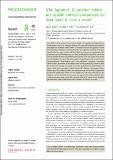What happened? Do preschool children and capuchin monkeys spontaneously use visual traces to locate a reward?
Abstract
The ability to infer unseen causes from evidence is argued to emerge early in development and to be uniquely human. We explored whether preschoolers and capuchin monkeys could locate a reward based on the physical traces left following a hidden event. Preschoolers and capuchin monkeys were presented with two cups covered with foil. Behind a barrier, an experimenter (E) punctured the foil coverings one at a time, revealing the cups with one cover broken after the first event and both covers broken after the second. One event involved hiding a reward, the other event was performed with a stick (order counterbalanced). Preschoolers and, with additional experience, monkeys could connect the traces to the objects used in the puncturing events to find the reward. Reversing the order of events perturbed the performance of 3-year olds and capuchins, while 4-year-old children performed above chance when the order of events was reversed from the first trial. Capuchins performed significantly better on the ripped foil task than they did on an arbitrary test in which the covers were not ripped but rather replaced with a differently patterned cover. We conclude that by 4 years of age children spontaneously reason backwards from evidence to deduce its cause.
Citation
Civelek , Z , Völter , C J & Seed , A M 2021 , ' What happened? Do preschool children and capuchin monkeys spontaneously use visual traces to locate a reward? ' , Proceedings of the Royal Society B: Biological Sciences , vol. 288 , no. 1956 , 20211101 . https://doi.org/10.1098/rspb.2021.1101
Publication
Proceedings of the Royal Society B: Biological Sciences
Status
Peer reviewed
ISSN
0962-8452Type
Journal article
Description
This project has received funding from the European Research Council (ERC) under the European Union's Horizon 2020 Research and Innovation Programme (grant agreement no. 639072). Edinburgh Zoo's Living Links Research Facility is core supported by the Royal Zoological Society of Scotland (registered charity no.: SC004064) through funding generated by its visitors, members and supporters.Collections
Items in the St Andrews Research Repository are protected by copyright, with all rights reserved, unless otherwise indicated.

